Organizational Performance Measurement and Analysis Report
VerifiedAdded on 2022/10/12
|7
|1464
|11
Report
AI Summary
This report provides a comprehensive analysis of organizational performance measurement, emphasizing its crucial role in effective governance and strategy execution. It delves into the significance of Key Performance Indicators (KPIs) across various organizational facets, including financial, customer, process, and people metrics. The financial metrics discussed encompass profitability, revenue analysis, sales, and budget efficiency, while customer metrics focus on satisfaction and acquisition. Process metrics highlight operational efficiency, and people metrics address employee satisfaction and turnover. The report illustrates these concepts with the example of the Coca-Cola Company, showcasing how it employs KPIs to strengthen its market position. The conclusion underscores the importance of performance measurement systems as a starting point for organizational analysis, enhancing productivity and aiding in the identification of areas for improvement. The report is well-supported with references to academic research on the subject.
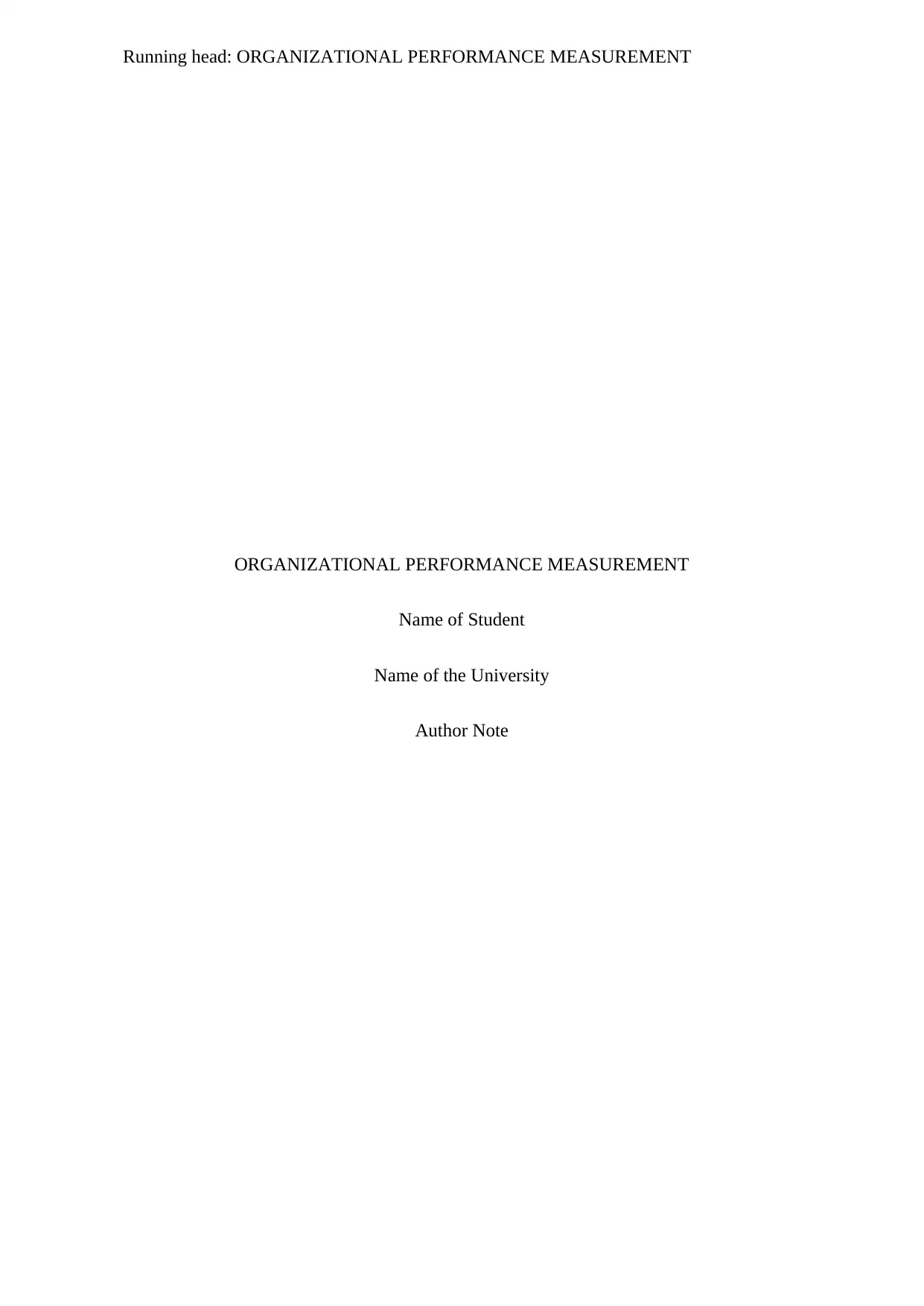
Running head: ORGANIZATIONAL PERFORMANCE MEASUREMENT
ORGANIZATIONAL PERFORMANCE MEASUREMENT
Name of Student
Name of the University
Author Note
ORGANIZATIONAL PERFORMANCE MEASUREMENT
Name of Student
Name of the University
Author Note
Paraphrase This Document
Need a fresh take? Get an instant paraphrase of this document with our AI Paraphraser
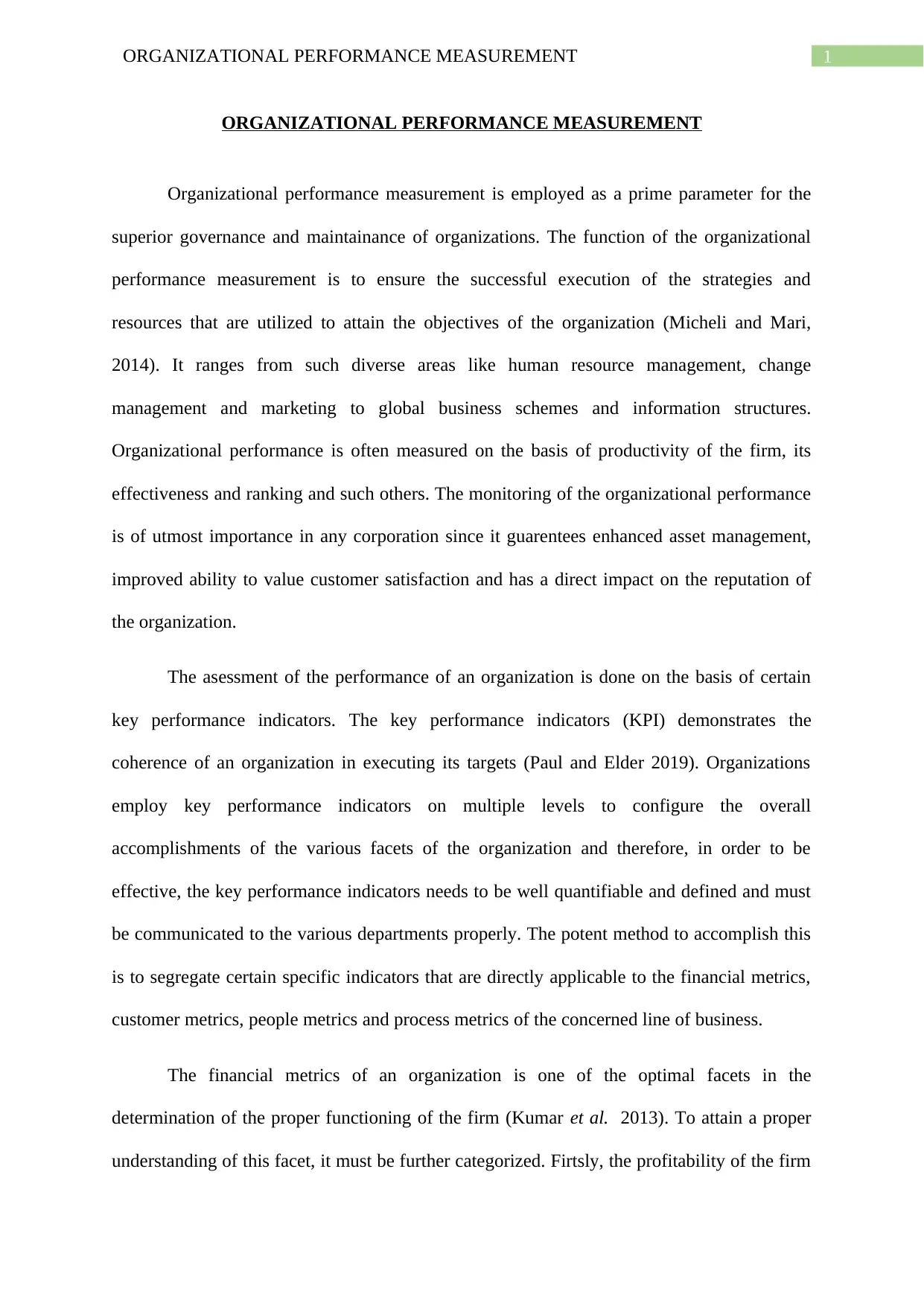
1ORGANIZATIONAL PERFORMANCE MEASUREMENT
ORGANIZATIONAL PERFORMANCE MEASUREMENT
Organizational performance measurement is employed as a prime parameter for the
superior governance and maintainance of organizations. The function of the organizational
performance measurement is to ensure the successful execution of the strategies and
resources that are utilized to attain the objectives of the organization (Micheli and Mari,
2014). It ranges from such diverse areas like human resource management, change
management and marketing to global business schemes and information structures.
Organizational performance is often measured on the basis of productivity of the firm, its
effectiveness and ranking and such others. The monitoring of the organizational performance
is of utmost importance in any corporation since it guarentees enhanced asset management,
improved ability to value customer satisfaction and has a direct impact on the reputation of
the organization.
The asessment of the performance of an organization is done on the basis of certain
key performance indicators. The key performance indicators (KPI) demonstrates the
coherence of an organization in executing its targets (Paul and Elder 2019). Organizations
employ key performance indicators on multiple levels to configure the overall
accomplishments of the various facets of the organization and therefore, in order to be
effective, the key performance indicators needs to be well quantifiable and defined and must
be communicated to the various departments properly. The potent method to accomplish this
is to segregate certain specific indicators that are directly applicable to the financial metrics,
customer metrics, people metrics and process metrics of the concerned line of business.
The financial metrics of an organization is one of the optimal facets in the
determination of the proper functioning of the firm (Kumar et al. 2013). To attain a proper
understanding of this facet, it must be further categorized. Firtsly, the profitability of the firm
ORGANIZATIONAL PERFORMANCE MEASUREMENT
Organizational performance measurement is employed as a prime parameter for the
superior governance and maintainance of organizations. The function of the organizational
performance measurement is to ensure the successful execution of the strategies and
resources that are utilized to attain the objectives of the organization (Micheli and Mari,
2014). It ranges from such diverse areas like human resource management, change
management and marketing to global business schemes and information structures.
Organizational performance is often measured on the basis of productivity of the firm, its
effectiveness and ranking and such others. The monitoring of the organizational performance
is of utmost importance in any corporation since it guarentees enhanced asset management,
improved ability to value customer satisfaction and has a direct impact on the reputation of
the organization.
The asessment of the performance of an organization is done on the basis of certain
key performance indicators. The key performance indicators (KPI) demonstrates the
coherence of an organization in executing its targets (Paul and Elder 2019). Organizations
employ key performance indicators on multiple levels to configure the overall
accomplishments of the various facets of the organization and therefore, in order to be
effective, the key performance indicators needs to be well quantifiable and defined and must
be communicated to the various departments properly. The potent method to accomplish this
is to segregate certain specific indicators that are directly applicable to the financial metrics,
customer metrics, people metrics and process metrics of the concerned line of business.
The financial metrics of an organization is one of the optimal facets in the
determination of the proper functioning of the firm (Kumar et al. 2013). To attain a proper
understanding of this facet, it must be further categorized. Firtsly, the profitability of the firm
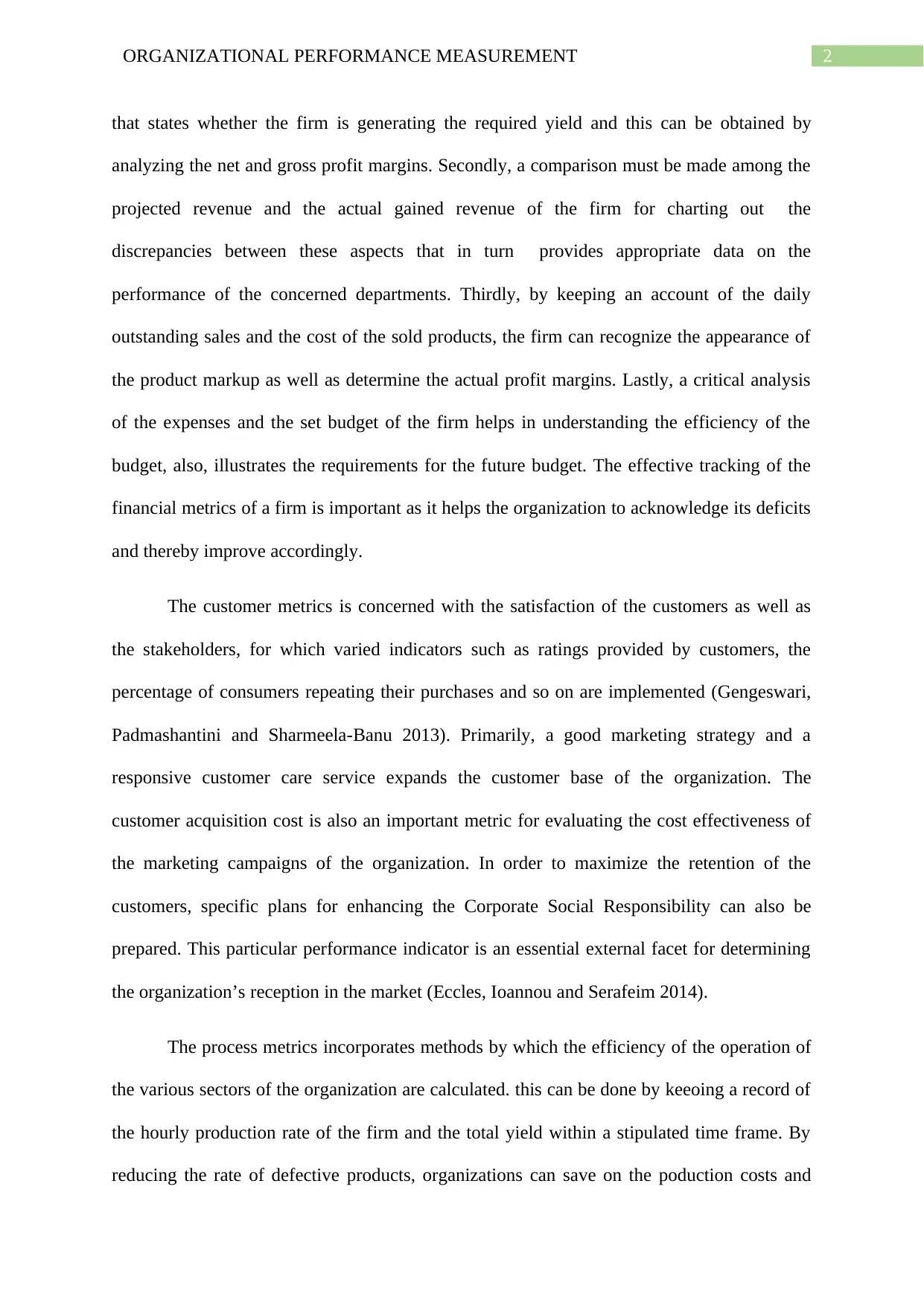
2ORGANIZATIONAL PERFORMANCE MEASUREMENT
that states whether the firm is generating the required yield and this can be obtained by
analyzing the net and gross profit margins. Secondly, a comparison must be made among the
projected revenue and the actual gained revenue of the firm for charting out the
discrepancies between these aspects that in turn provides appropriate data on the
performance of the concerned departments. Thirdly, by keeping an account of the daily
outstanding sales and the cost of the sold products, the firm can recognize the appearance of
the product markup as well as determine the actual profit margins. Lastly, a critical analysis
of the expenses and the set budget of the firm helps in understanding the efficiency of the
budget, also, illustrates the requirements for the future budget. The effective tracking of the
financial metrics of a firm is important as it helps the organization to acknowledge its deficits
and thereby improve accordingly.
The customer metrics is concerned with the satisfaction of the customers as well as
the stakeholders, for which varied indicators such as ratings provided by customers, the
percentage of consumers repeating their purchases and so on are implemented (Gengeswari,
Padmashantini and Sharmeela-Banu 2013). Primarily, a good marketing strategy and a
responsive customer care service expands the customer base of the organization. The
customer acquisition cost is also an important metric for evaluating the cost effectiveness of
the marketing campaigns of the organization. In order to maximize the retention of the
customers, specific plans for enhancing the Corporate Social Responsibility can also be
prepared. This particular performance indicator is an essential external facet for determining
the organization’s reception in the market (Eccles, Ioannou and Serafeim 2014).
The process metrics incorporates methods by which the efficiency of the operation of
the various sectors of the organization are calculated. this can be done by keeoing a record of
the hourly production rate of the firm and the total yield within a stipulated time frame. By
reducing the rate of defective products, organizations can save on the poduction costs and
that states whether the firm is generating the required yield and this can be obtained by
analyzing the net and gross profit margins. Secondly, a comparison must be made among the
projected revenue and the actual gained revenue of the firm for charting out the
discrepancies between these aspects that in turn provides appropriate data on the
performance of the concerned departments. Thirdly, by keeping an account of the daily
outstanding sales and the cost of the sold products, the firm can recognize the appearance of
the product markup as well as determine the actual profit margins. Lastly, a critical analysis
of the expenses and the set budget of the firm helps in understanding the efficiency of the
budget, also, illustrates the requirements for the future budget. The effective tracking of the
financial metrics of a firm is important as it helps the organization to acknowledge its deficits
and thereby improve accordingly.
The customer metrics is concerned with the satisfaction of the customers as well as
the stakeholders, for which varied indicators such as ratings provided by customers, the
percentage of consumers repeating their purchases and so on are implemented (Gengeswari,
Padmashantini and Sharmeela-Banu 2013). Primarily, a good marketing strategy and a
responsive customer care service expands the customer base of the organization. The
customer acquisition cost is also an important metric for evaluating the cost effectiveness of
the marketing campaigns of the organization. In order to maximize the retention of the
customers, specific plans for enhancing the Corporate Social Responsibility can also be
prepared. This particular performance indicator is an essential external facet for determining
the organization’s reception in the market (Eccles, Ioannou and Serafeim 2014).
The process metrics incorporates methods by which the efficiency of the operation of
the various sectors of the organization are calculated. this can be done by keeoing a record of
the hourly production rate of the firm and the total yield within a stipulated time frame. By
reducing the rate of defective products, organizations can save on the poduction costs and
⊘ This is a preview!⊘
Do you want full access?
Subscribe today to unlock all pages.

Trusted by 1+ million students worldwide
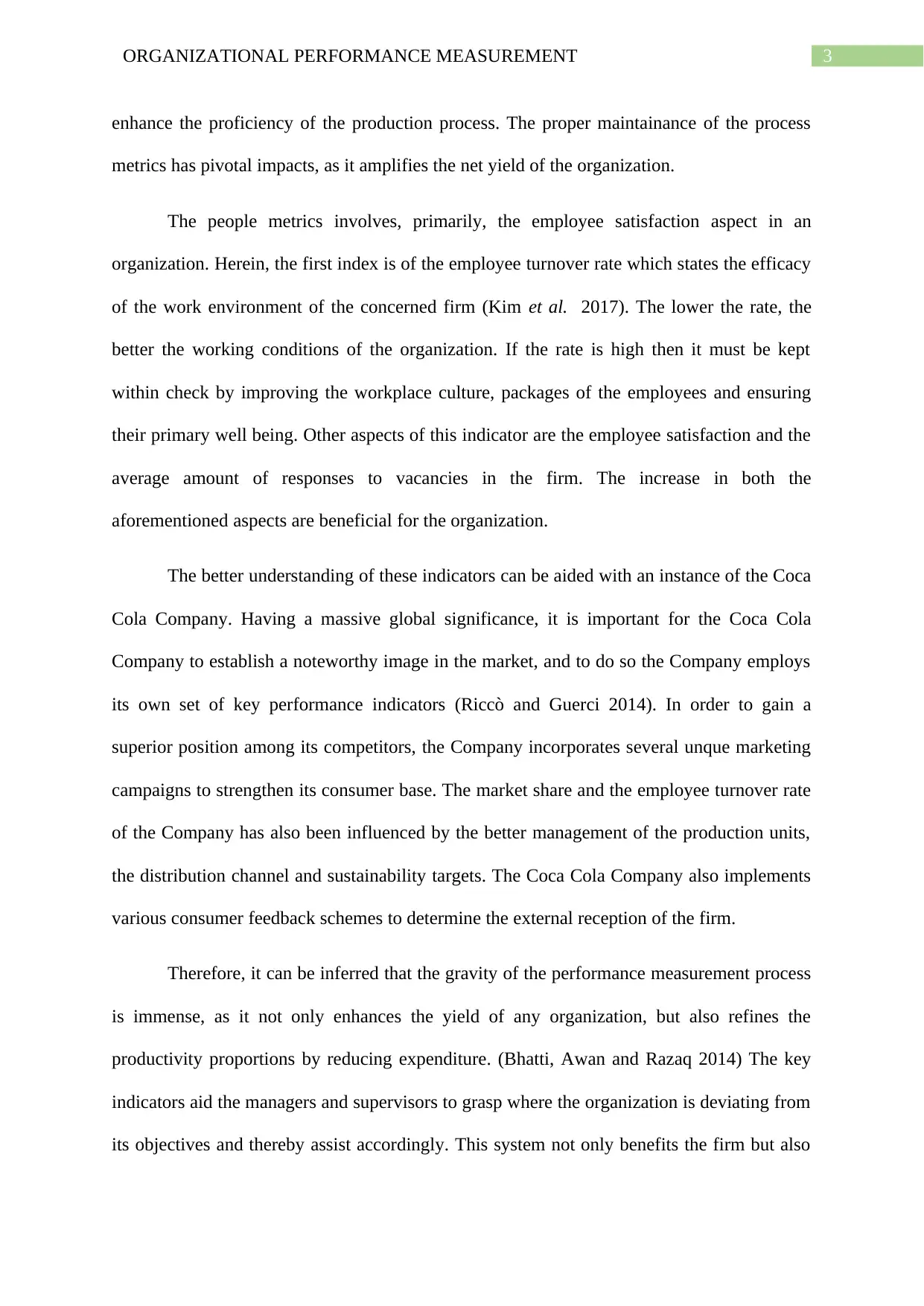
3ORGANIZATIONAL PERFORMANCE MEASUREMENT
enhance the proficiency of the production process. The proper maintainance of the process
metrics has pivotal impacts, as it amplifies the net yield of the organization.
The people metrics involves, primarily, the employee satisfaction aspect in an
organization. Herein, the first index is of the employee turnover rate which states the efficacy
of the work environment of the concerned firm (Kim et al. 2017). The lower the rate, the
better the working conditions of the organization. If the rate is high then it must be kept
within check by improving the workplace culture, packages of the employees and ensuring
their primary well being. Other aspects of this indicator are the employee satisfaction and the
average amount of responses to vacancies in the firm. The increase in both the
aforementioned aspects are beneficial for the organization.
The better understanding of these indicators can be aided with an instance of the Coca
Cola Company. Having a massive global significance, it is important for the Coca Cola
Company to establish a noteworthy image in the market, and to do so the Company employs
its own set of key performance indicators (Riccò and Guerci 2014). In order to gain a
superior position among its competitors, the Company incorporates several unque marketing
campaigns to strengthen its consumer base. The market share and the employee turnover rate
of the Company has also been influenced by the better management of the production units,
the distribution channel and sustainability targets. The Coca Cola Company also implements
various consumer feedback schemes to determine the external reception of the firm.
Therefore, it can be inferred that the gravity of the performance measurement process
is immense, as it not only enhances the yield of any organization, but also refines the
productivity proportions by reducing expenditure. (Bhatti, Awan and Razaq 2014) The key
indicators aid the managers and supervisors to grasp where the organization is deviating from
its objectives and thereby assist accordingly. This system not only benefits the firm but also
enhance the proficiency of the production process. The proper maintainance of the process
metrics has pivotal impacts, as it amplifies the net yield of the organization.
The people metrics involves, primarily, the employee satisfaction aspect in an
organization. Herein, the first index is of the employee turnover rate which states the efficacy
of the work environment of the concerned firm (Kim et al. 2017). The lower the rate, the
better the working conditions of the organization. If the rate is high then it must be kept
within check by improving the workplace culture, packages of the employees and ensuring
their primary well being. Other aspects of this indicator are the employee satisfaction and the
average amount of responses to vacancies in the firm. The increase in both the
aforementioned aspects are beneficial for the organization.
The better understanding of these indicators can be aided with an instance of the Coca
Cola Company. Having a massive global significance, it is important for the Coca Cola
Company to establish a noteworthy image in the market, and to do so the Company employs
its own set of key performance indicators (Riccò and Guerci 2014). In order to gain a
superior position among its competitors, the Company incorporates several unque marketing
campaigns to strengthen its consumer base. The market share and the employee turnover rate
of the Company has also been influenced by the better management of the production units,
the distribution channel and sustainability targets. The Coca Cola Company also implements
various consumer feedback schemes to determine the external reception of the firm.
Therefore, it can be inferred that the gravity of the performance measurement process
is immense, as it not only enhances the yield of any organization, but also refines the
productivity proportions by reducing expenditure. (Bhatti, Awan and Razaq 2014) The key
indicators aid the managers and supervisors to grasp where the organization is deviating from
its objectives and thereby assist accordingly. This system not only benefits the firm but also
Paraphrase This Document
Need a fresh take? Get an instant paraphrase of this document with our AI Paraphraser
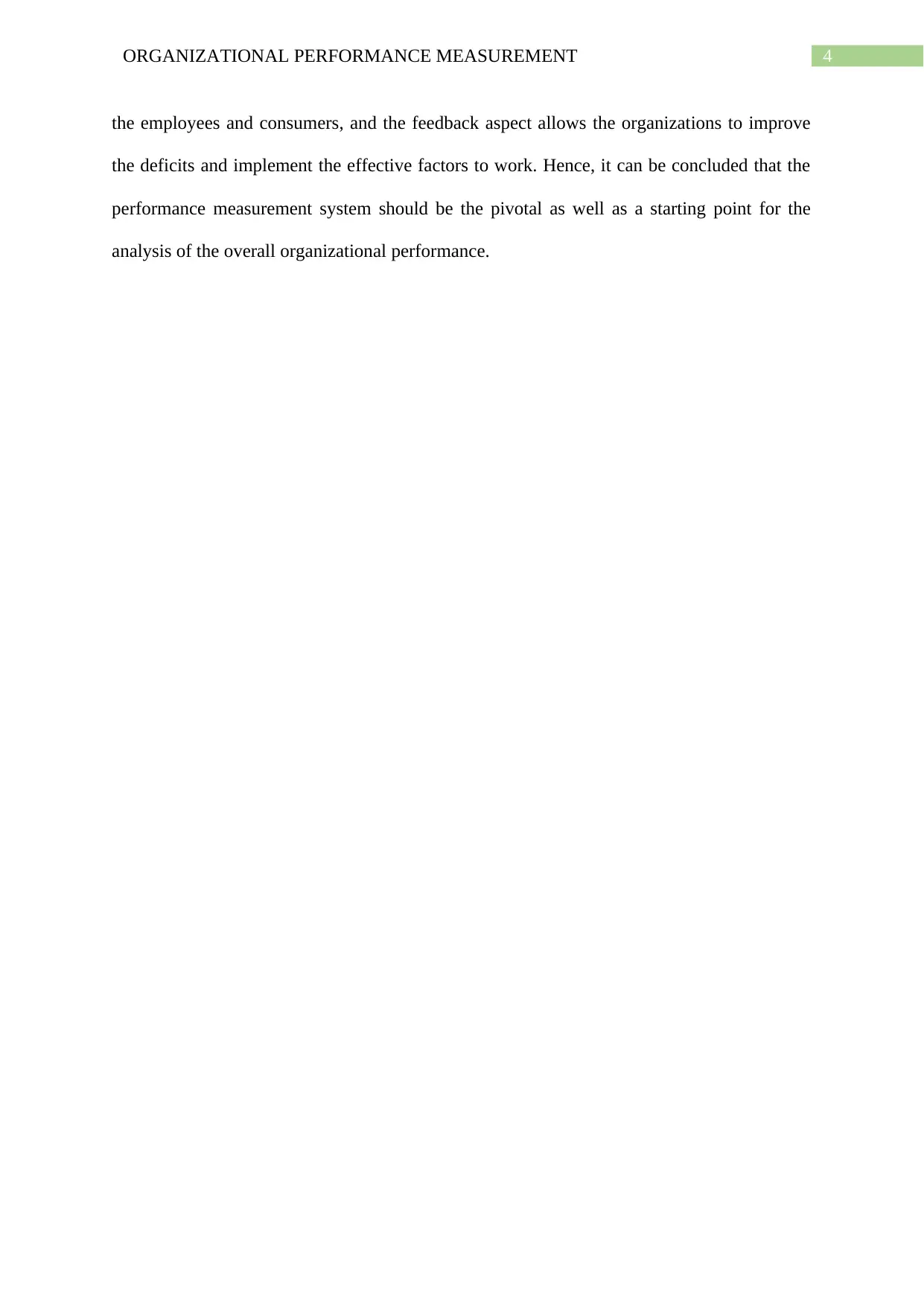
4ORGANIZATIONAL PERFORMANCE MEASUREMENT
the employees and consumers, and the feedback aspect allows the organizations to improve
the deficits and implement the effective factors to work. Hence, it can be concluded that the
performance measurement system should be the pivotal as well as a starting point for the
analysis of the overall organizational performance.
the employees and consumers, and the feedback aspect allows the organizations to improve
the deficits and implement the effective factors to work. Hence, it can be concluded that the
performance measurement system should be the pivotal as well as a starting point for the
analysis of the overall organizational performance.
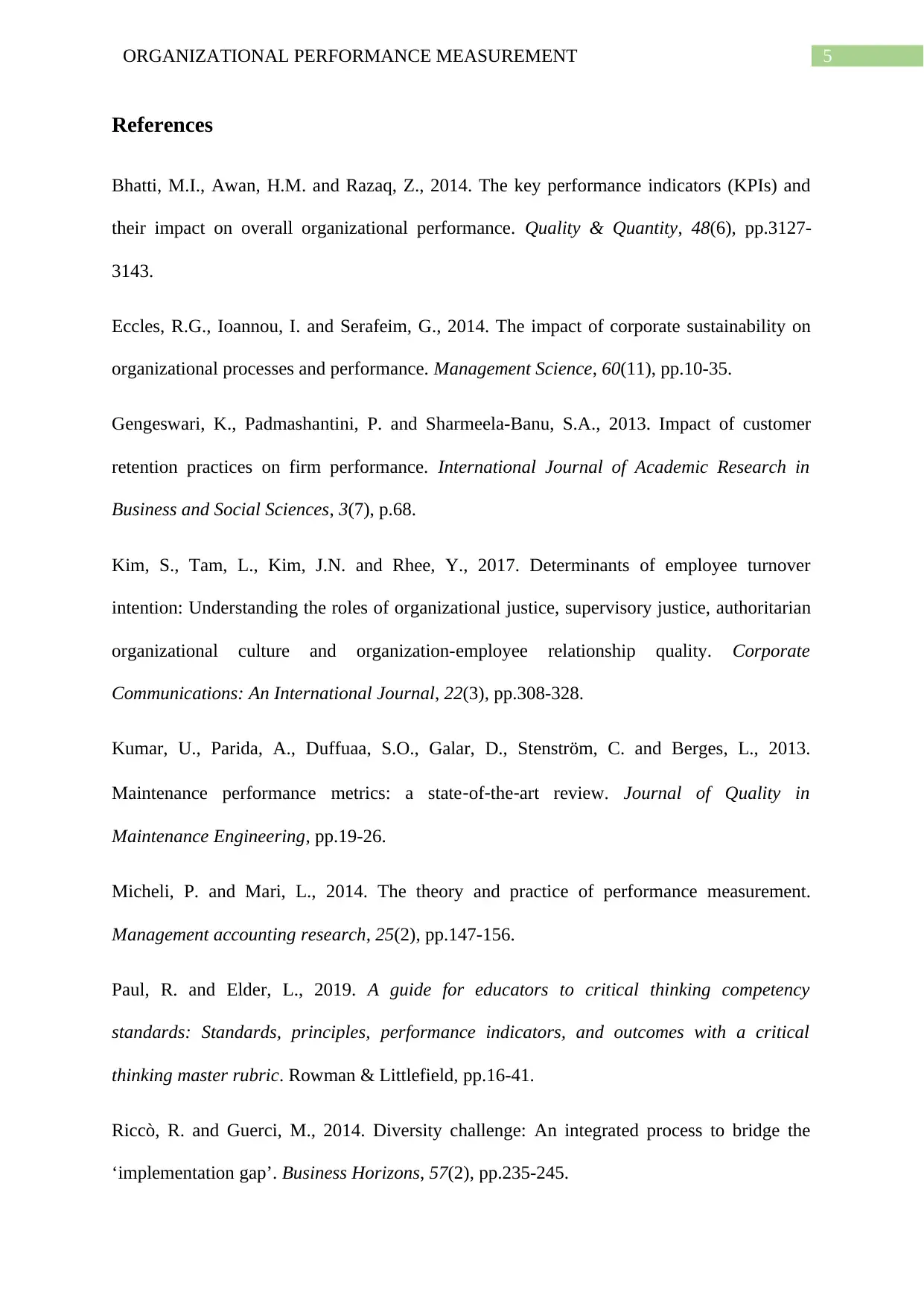
5ORGANIZATIONAL PERFORMANCE MEASUREMENT
References
Bhatti, M.I., Awan, H.M. and Razaq, Z., 2014. The key performance indicators (KPIs) and
their impact on overall organizational performance. Quality & Quantity, 48(6), pp.3127-
3143.
Eccles, R.G., Ioannou, I. and Serafeim, G., 2014. The impact of corporate sustainability on
organizational processes and performance. Management Science, 60(11), pp.10-35.
Gengeswari, K., Padmashantini, P. and Sharmeela-Banu, S.A., 2013. Impact of customer
retention practices on firm performance. International Journal of Academic Research in
Business and Social Sciences, 3(7), p.68.
Kim, S., Tam, L., Kim, J.N. and Rhee, Y., 2017. Determinants of employee turnover
intention: Understanding the roles of organizational justice, supervisory justice, authoritarian
organizational culture and organization-employee relationship quality. Corporate
Communications: An International Journal, 22(3), pp.308-328.
Kumar, U., Parida, A., Duffuaa, S.O., Galar, D., Stenström, C. and Berges, L., 2013.
Maintenance performance metrics: a state‐of‐the‐art review. Journal of Quality in
Maintenance Engineering, pp.19-26.
Micheli, P. and Mari, L., 2014. The theory and practice of performance measurement.
Management accounting research, 25(2), pp.147-156.
Paul, R. and Elder, L., 2019. A guide for educators to critical thinking competency
standards: Standards, principles, performance indicators, and outcomes with a critical
thinking master rubric. Rowman & Littlefield, pp.16-41.
Riccò, R. and Guerci, M., 2014. Diversity challenge: An integrated process to bridge the
‘implementation gap’. Business Horizons, 57(2), pp.235-245.
References
Bhatti, M.I., Awan, H.M. and Razaq, Z., 2014. The key performance indicators (KPIs) and
their impact on overall organizational performance. Quality & Quantity, 48(6), pp.3127-
3143.
Eccles, R.G., Ioannou, I. and Serafeim, G., 2014. The impact of corporate sustainability on
organizational processes and performance. Management Science, 60(11), pp.10-35.
Gengeswari, K., Padmashantini, P. and Sharmeela-Banu, S.A., 2013. Impact of customer
retention practices on firm performance. International Journal of Academic Research in
Business and Social Sciences, 3(7), p.68.
Kim, S., Tam, L., Kim, J.N. and Rhee, Y., 2017. Determinants of employee turnover
intention: Understanding the roles of organizational justice, supervisory justice, authoritarian
organizational culture and organization-employee relationship quality. Corporate
Communications: An International Journal, 22(3), pp.308-328.
Kumar, U., Parida, A., Duffuaa, S.O., Galar, D., Stenström, C. and Berges, L., 2013.
Maintenance performance metrics: a state‐of‐the‐art review. Journal of Quality in
Maintenance Engineering, pp.19-26.
Micheli, P. and Mari, L., 2014. The theory and practice of performance measurement.
Management accounting research, 25(2), pp.147-156.
Paul, R. and Elder, L., 2019. A guide for educators to critical thinking competency
standards: Standards, principles, performance indicators, and outcomes with a critical
thinking master rubric. Rowman & Littlefield, pp.16-41.
Riccò, R. and Guerci, M., 2014. Diversity challenge: An integrated process to bridge the
‘implementation gap’. Business Horizons, 57(2), pp.235-245.
⊘ This is a preview!⊘
Do you want full access?
Subscribe today to unlock all pages.

Trusted by 1+ million students worldwide

6ORGANIZATIONAL PERFORMANCE MEASUREMENT
1 out of 7
Related Documents
Your All-in-One AI-Powered Toolkit for Academic Success.
+13062052269
info@desklib.com
Available 24*7 on WhatsApp / Email
![[object Object]](/_next/static/media/star-bottom.7253800d.svg)
Unlock your academic potential
Copyright © 2020–2025 A2Z Services. All Rights Reserved. Developed and managed by ZUCOL.





